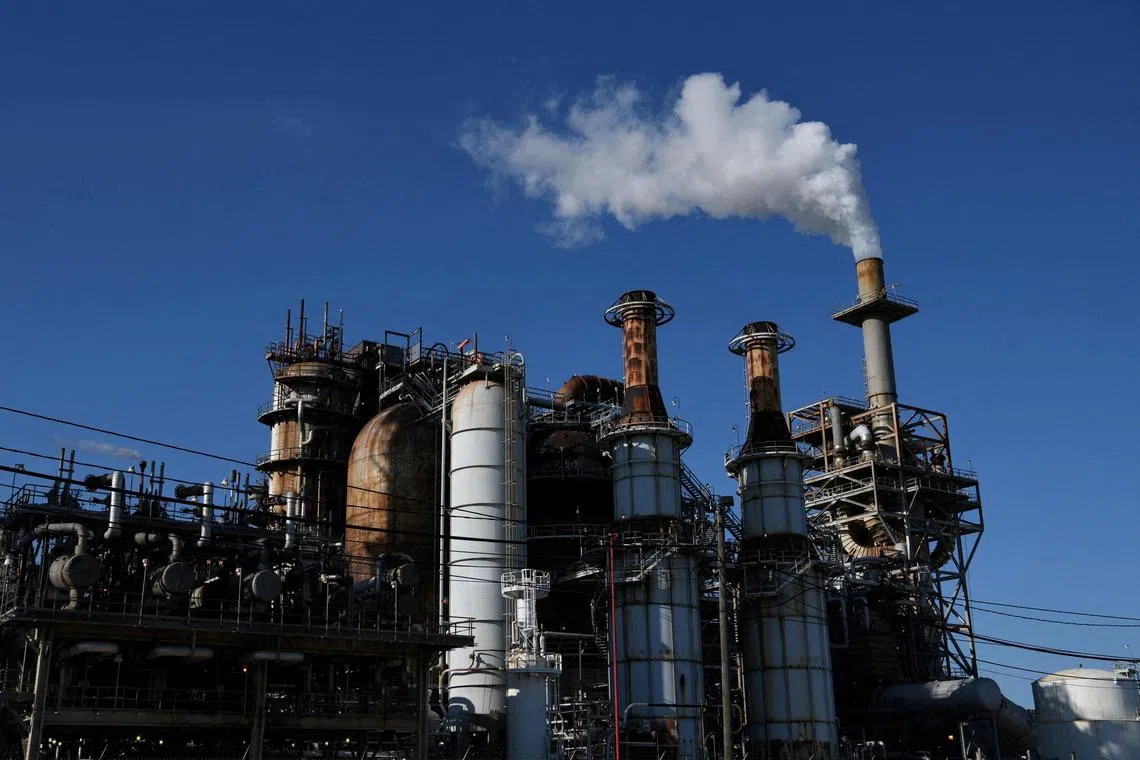Trump lays out plan to unleash American fossil fuels, halt climate cooperation
Sign up now: Get ST's newsletters delivered to your inbox

US President Donald Trump’s moves signal a dramatic U-turn in Washington’s energy policy.
PHOTO: REUTERS
Follow topic:
WASHINGTON – US President Donald Trump on Jan 20 laid out a sweeping plan to maximise US oil and gas production – including by declaring a national energy emergency, stripping away excess regulation, and withdrawing the US from an international pact to fight climate change.
The moves signal a dramatic U-turn in Washington’s energy policy after former US president Joe Biden sought for four years to encourage a transition away from fossil fuels in the world’s largest economy and establish the US as a leader in combating global warming.
But it remains to be seen if the measures will have any impact on production, which is already at record levels as drillers chase high prices in the wake of sanctions on Russia after its 2022 invasion of Ukraine.
“America will be a manufacturing nation once again, and we have something that no other manufacturing nation will ever have: the largest amount of oil and gas of any country on earth,” Mr Trump said during his inauguration speech. “And we are going to use it.”
He later signed an executive order declaring a national energy emergency and withdrawing the US from the 2015 Paris climate deal
He also signed orders aimed at promoting oil and gas development in Alaska, reversing Mr Biden’s efforts to protect vast Arctic lands and US coastal waters from drilling, revoking Mr Biden’s target for electric vehicle (EV) adoption, suspending offshore wind lease sales, and lifting a freeze on liquefied natural gas export permitting.
Mr Trump said he expects the orders to help reduce consumer prices and improve US national security.
“We will bring prices down, fill our strategic reserves up again, right to the top, and export American energy all over the world,” he said.
Environmental groups have said they intend to challenge the executive orders in court.
Mr Biden’s administration sought to encourage electric vehicle use by offering a consumer subsidy for new EV purchases, and by imposing tougher tailpipe emissions standards on automakers.
It also sought to encourage clean energy technologies using taxpayer subsidies that have drawn billions of dollars in manufacturing investments.
The Democratic National Committee called Mr Trump’s day one agenda a “disaster for working families”.
“Killing manufacturing jobs and giving a free pass to polluters that make people sick is hardly putting ‘America first,’” said Mr Alex Floyd, DNC spokesman.
Power industry overhaul
Mr Trump had promised during his campaign to declare a national energy emergency, arguing the US should produce more fossil fuels and also modernise electrical infrastructure and ramp up power generation to meet rising demand.
US data centre power use could nearly triple in the next three years, and consume as much as 12 per cent of the country’s electricity on demand from AI and other technologies, the US Department of Energy projects.
Mr Trump’s declaration seeks to ease environmental restrictions on power plants, speed up construction of new plants, ease permitting for transmission and pipeline projects, and open up new federal lands to development.
“It allows you to do whatever you’ve got to do to get ahead of that problem,” Mr Trump said while signing the order. “And we do have that kind of an emergency.”
Mr Sam Sankar, senior vice-president for programmes at Earthjustice, a non-profit group which is gearing up to fight Trump policies in the courts, said the declaration of an energy emergency in a non-war period is rare and untested, creating a potential legal vulnerability.
The first Trump administration had considered using emergency powers under the Federal Power Act to attempt to carry out a pledge to rescue the coal industry, but never followed through.
Mr Trump’s promise to refill strategic reserves, meanwhile, has the potential to lift oil prices by boosting demand for US crude oil.
After the invasion of Ukraine, Mr Biden had sold more than 180 million barrels of crude oil from the US Strategic Petroleum Reserve, a record amount. The sales helped keep gasoline prices in check, but sank the reserve to the lowest level in 40 years. REUTERS

